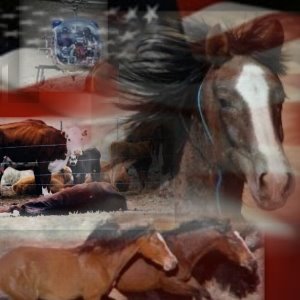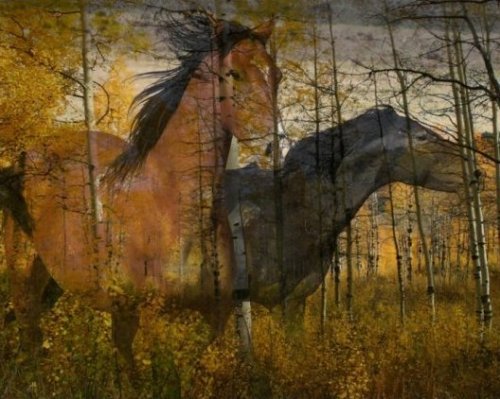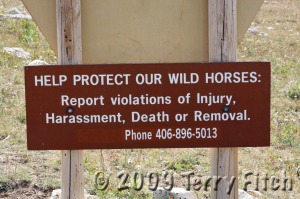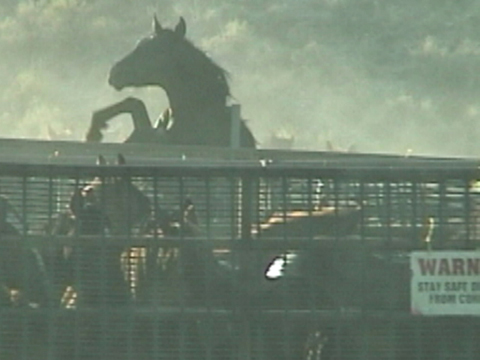CONGRESS FINDS AND DECLARES THAT WILD FREE-ROAMING HORSES AND BURROS ARE LIVING SYMBOLS OF THE HISTORIC AND PIONEER SPIRIT OF THE WEST, THAT THEY CONTRIBUTE TO THE DIVERSITY OF LIFE FORMS WITHIN THE NATION AND ENRICH THE LIVES OF THE AMERICAN PEOPLE, AND THAT THESE HORSES AND BURROS ARE FAST DISAPPEARING FROM THE AMERICAN SCENE, IT IS THE POLICY OF THE CONGRESS THAT WILD FREE-ROAMING HORSES AND BURROS SHALL BE PROTECTED FROM CAPTURE, BRANDING, HARASSMENT, OR DEATH, AND TO ACCOMPLISH THIS THEY ARE TO BE CONSIDERED IN THE AREA WHERE PRESENTLY FOUND AS AN INTEGRAL PART OF THE NATURAL SYSTEM OF PUBLIC LAND.


Wild Horses: Exposing the Myths
(Courtesy of the Animal Protection Institute)
In 1971, Congress recognized that wild horses and burros “are living symbols of the historic and pioneer spirit of the West” by enacting the Wild Free-Roaming Horses and Burros Act. This law seeks to protect “from capture, branding, harassment, or death” wild horses and burros found on public lands in the United States. Yet the law has never been fully implemented by the Department of the Interior, the agency of the federal government charged with its administration. Below are common misconceptions — and the real facts — about wild horses.
MYTH: Wild horses and burros are exotic, non-native species rightfully categorized as “feral” domestic animals.
False. The Wild Horses and Burros Act recognizes the wild horse as an “integral component of the natural system.” Paleontological evidence shows that wild horses and burros evolved on the North American continent over the course of some 60,000,000 years. How they disappeared 8,000 to 10,000 years ago, if in fact they actually ever became extinct here, is a mystery. It is suspected that the horses were hunted to near extinction by humans who had crossed the ice bridge into North America. When Cortez landed in Mexico in 1519, he brought horses from Spain. Others followed. From these reintroduced animals came the great numbers of wild horses which eventually changed the culture of the Plains Indians.
The Spanish horses soon adapted to the same ecological niche their native relatives had once inhabited here. Every trait and characteristic that describes a native wildlife species fits the American wild horse and desert burro. Long before the early settlers and homesteaders pioneered the West, they were here as a reintroduced, fully adapted species. When the U.S. government acquired land through the Louisiana Purchase and from Mexico, also acquired were the wild horses. As many as 3 million wild horses existed on public domain lands. Their home territory stretched from the Carizzo Plains and Santa Lucia Mountains of California, east to Missouri, and north to North Dakota and into Canada.
MYTH: Wild horses and burros don’t really need legal protection. The law was passed in response to the lobbying of a few “horse lovers” and school children.
False. Prior to the passage of the wild horse law, free lance cowboys (“mustangers”) were selling wild horses, which are government property, without a license to dog food manufacturers. Using trucks and helicopters to round up the animals, the cowboys often left injured horses to die slowly in the desert. This outraged Velma Johnston, a resident of Reno, Nevada, whose actions on the horses’ behalf gave her the nickname “Wild Horse Annie.” As a result of the national publicity generated by Mrs. Johnston and others, a law was passed in 1959 to prohibit the use of aircraft or motor vehicles to hunt certain wild horses and burros on federally owned land. This law also made it illegal to “pollute any watering hole on any of the public land or ranges for the purpose of trapping, killing, wounding, or maiming any of such animals.”
However, the 1959 law did not prevent commercial interests from rounding up horses and burros and selling them for profit. Further protection for wild horses and burros was provided by the 1971 Wild Free-Roaming Horses and Burros Act, the result of overwhelming nationwide public support. Both chambers of Congress passed the Act unanimously — not one Senator or Representative voted against it. Congress chose to protect wild horses and burros as a heritage species.

MYTH: There is an overpopulation of wild horses on public lands.
False. There is no overpopulation of wild horses and burros. The condition of the land, not the number of animals, determines whether or not a wild horse overpopulation exists in a particular area. The wild horse law says that in a given area, a certain amount of vegetation may be eaten as forage. Only when that amount is exceeded are there too many animals.
The Bureau of Land Management (BLM) has changed the definition of overpopulation as given in the wild horse law. The BLM has declared that overpopulation is any amount above its desired management number of 21,000 animals. The BLM’s 1997 report to Congress claimed an estimated 43,000 wild horses and burros on rangelands, a figure based on maximum reproductive rates to ensure funding from Congress to continue to remove horses and burros from public lands. The Animal Protection Institute and others contend that less than 20,000 animals actually remain on the land.
MYTH: The BLM removes wild horses and burros to keep the number of animals at a level the range can support.
False. Wild horse and burro populations are being severely reduced, but not to protect the range. Ranchers demand that wild horses be removed to protect forage historically allocated for livestock use.
The law requires that the BLM measure the impact of the animal population on the habitat to determine if there are too many animals in a given area. But, according to a 1990 investigation by the General Accounting Office (GAO), BLM decisions on how many horses to remove from public lands have not been based on any evidence that wild horse populations exceed what the range can support. Moreover, the GAO found that wild horse removals often have not been accompanied by reductions in livestock grazing. In some cases, the BLM has increased authorized livestock grazing levels after removing wild horses. As a result, range conditions have not improved.
The law authorizes the BLM to remove wild horses and burros “when they pose a threat to themselves, their habitat, or other rangeland values.” However, only the number needed to restore the natural ecological balance between wild horses, other wildlife, and their habitat may be removed. Thus, the law prohibits the BLM from maintaining a predetermined number of animals. This interpretation of the law has been confirmed by a federal court decision and rulings of the Interior Board of Land Appeals, as well as the GAO findings.

MYTH: Wild horses compete with cows for forage.
False. Wild horses do not compete with cattle for the same available forage. Cows graze within a mile of water, while wild horses are highly mobile, grazing from five to ten miles from water, at higher elevations, on steeper slopes, and in more rugged terrain. A congressionally mandated study by the National Academy of Science found that wild horses and burros are not responsible for overgrazing on public lands. The study also revealed that, in one year, livestock consumed 70% of grazing resources on public lands, while wild horses and burros consumed less than 5%. Cattle outnumber wild horses on public lands by approximately 1,000 to 1.
MYTH: Where BLM manages wild horses and burros is a land-use decision to be determined at the local level.
False. The sole and exclusive authority for where wild horses are to be managed is stated in the wild horse law. It says that the BLM must manage and protect wild horses and burros where they existed in 1971, at the time the law passed. The only land-use decision authorized by the wild horse law is whether to designate an area where wild horses and burros are known to have existed in 1971 as exclusive habitat for the animals, or as multiple-use land. Lands designated as multiple-use are to be managed “principally but not exclusively” for wild horses and burros. The BLM may not expand the range for wild horses and burros or open up new areas for their use. Despite the requirements and directives of the law, BLM officials insist that where they manage wild horses and how many are to be managed are decisions to be made as a part of local land-use deliberations.
In 1984, there were 303 identified wild horse and burro use areas on 47 million acres of land. By 1997, only 186 of those areas contained wild horses or burros. Through land-use planning decisions, the BLM has emptied 117 herd use areas and reduced wild horse habitat area to less than 35 million acres. The BLM plans to empty 60 more wild horse areas despite the law prohibiting it.

MYTH: The BLM may at its discretion dispose of animals considered to be excess.
False. The law allows for three methods of lowering the number of animals in a particular area after the determination is made that an overpopulation exists and a reduction is needed. Excess horses may:
be relocated to other areas of public land,
be destroyed in a humane manner, or
be removed from the range and placed in the care of qualified individuals or organizations.
A BLM program allows “qualified individuals or organizations” to adopt, for a nominal fee, animals removed from the range. This adoption program has been used by the BLM to remove large numbers of horses and burros from public land, a practiced encouraged by the ranching industry, which views all wildlife as competing with livestock.
Between 1980 and 1990, the BLM rounded up, removed, and disposed of more than 80,000 wild horses, about 60,000 of whom were processed through the Adopt-A-Horse program. The BLM does not have the authority to sell wild horses. Providing the BLM with sale authority would allow the animals to be sold for commercial purposes, including slaughter. In the 1980s, several attempts were made to amend the law to include BLM sale authority, and each time the public protested.
When these bids to gain sale authority failed, the BLM instituted a special fee-waived, mass adoption program to serve as a disposal system for handling large numbers of horses removed from the range. A federal court ruling eventually ended the mass adoption program, leaving more than 3,000 horses in the system in need of homes. The BLM continues to allocate about half of its wild horse program budget to rounding up horses for adoption even though many animals are currently in the system awaiting adoption.
MYTH: A horse may be sold for slaughter if the adopter obtains an official title.
False. Although the BLM maintains that a horse may be sold for slaughter if the horse is first adopted and the adopter obtains an official title, this was not the intent of Congress when it passed the wild horse protection law. The law says that, after one year, an adopted wild horse or burro loses legal protections provided the animal is not sold or transferred for compensation or commercial purposes.
In the late 1980s, API and The Fund for Animals challenged the BLM’s fee-waived, mass adoption program on the grounds that the BLM knew in advance that the adopters intended to sell or commercially exploit the horses, and thus were not qualified adopters. The Court found in API’s favor and instructed the BLM not to transfer title when the adopter planned to use the animal for commercial purposes. This decision was upheld on appeal. Nonetheless, investigations reveal that BLM agents have, in fact, placed horses with people with the knowledge that the horses would be sold for slaughter.
In 1997, API and The Fund for Animals returned to court to request that the 1987 injunction be enforced and strengthened to protect wild horses from going to slaughter. As a result of the lawsuit, the BLM agreed to reform its requirements for adopting wild horses to prevent these rampant abuses. In the settlement, the BLM agreed to reword its Private Maintenance and Care Agreement so that anyone who adopts a wild horse or burro for slaughter or commercial purposes may be prosecuted. The agency also promised it would prohibit using the powers of attorney in the adoption process, and that U.S. Department of Agriculture inspectors will notify BLM when horses with the BLM freeze-brand arrive at a slaughterhouse.
API is prepared to take whatever actions are necessary to see that the practice of selling wild horses for slaughter ends and that the original intent and language of the law is followed.

“[Wild free-roaming horses and burros] belong to no one individual. They belong to all the American people. The spirit which has kept them alive and free against almost insurmountable odds typifies the national spirit which led to the growth of our Nation. They are living symbols of the rugged independence and tireless energy of our pioneer heritage.”
(U.S. Senate Report No. 242, 92nd Congress, 1971)












